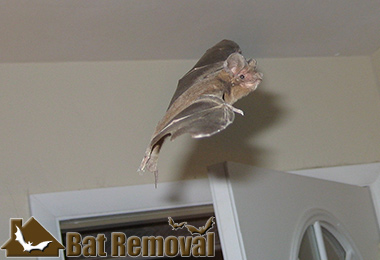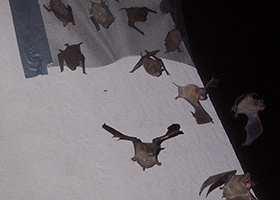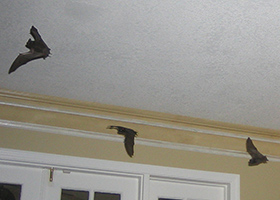Mobile Bat Removal
Welcome to Mobile Bat Removal! We are Alabama bat removal specialists. It is important to know that bats are protected by Alabama law, and are beneficial animals to have in the environment. We do not kill any bats during our bat removal process. Never hire a pest control company or anyone who says they are a Mobile bat exterminator. For correct and effective bat removal, you want a company that specializes in humane bat colony extraction. Our process is not only the only legal method in Alabama, but it is the most effective. We have a 100% success rate in our bat control process. We perform our industry-best 32-point inspection of your house or building, and seal shut all bat entry holes down to 1/4 inch as part of the removal process, during which we remove the colony via special one-way exclusion devices specific to your architecture. Once all bats are safely out, we permanenetly bat-proof the structure. We also provide guano (bat droppings) removal and decon. Click on our Mobile Bat Control Prices page to find out more about our prices for bat control work. We work 24/7/365, and would love to talk to you about your bat problem. Call us any time at 251-545-3260 to discuss it, discuss our pricing, and if you wish, set up an appointment at your convenience, often same-day.

Mobile Building and Attic Inspections

No-kill Alabama Bat Extraction

Guano Cleanouts - Serving all of Alabama
Call 24/7 to discuss your bat problem.
Same-day or next-day appointments.
32-point inspection of your property.
Written estimates for bat removal project.
Fully state licensed and insured.
Residential and commercial service
100% no-kill Mobile bat extraction
Complete bat-proofing of your building
Compliance with all Alabama, federal laws
Guano removal and attic decontamination
Our Service Range - 251-545-3260



Facts and Information on Little Brown Bats
Little brown bat is one of the most common and most abundant species of bats in the North American continent. It is mainly found in the northern section of the US and southern part of Canada. Nonetheless, it can also thrive in different parts of the continent based on its distribution. They can fly at about 20mph and will use their echolocation and high-frequency sound to avoid colliding with solid objects.
Appearance of the Little Brown Bats
The little brown bat is unique for its shiny and brown fur. This bat has a pair of pointed ears and have fur on its toes. It grows at around 3-5in in terms of length and can weigh at an average of 1/16-1/20z. The standard wingspan measures at 9-11in. The female bats are usually larger than their male counterparts. The fur located on its upper body and back has a darker shade while the fur on its belly will be lighter. It also has a dark brown wing membrane.
Life Cycle
The breeding season of the little brown bats happened during the fall season. However, the ovulation will only start on the spring. The female bats will build a nursery colony that may include thousands of bats. The mother will care for their young ones for around two weeks. After three weeks, the young bat will now be ready to leave its home. The pups will be joining the mother bats on her daily forage by clinging tightly on the mother's fur. The male will reach sexual maturity after a year while the female may become sexually receptive after only 9 months. They have a life expectancy of around 20 years. There were also records of little brown bats that lived up to 30 years.
Diet
The natural diet of the little brown bat is mainly composed of flying insects. This may include beetles, moths, mayflies, mosquitoes, lace wings, caddisflies, and midges. The females during their lactating period will have to eat insects that weighs 110 percent of their total body mass. According to the experts, a bat may eat 300-3,000 insects per night. Therefore, a million bats will devour a total of 694tons of insects per year. Due to their habits of eating insects that can potentially destroy crops, they are known to be beneficial especially on agricultural settings. Farmers on the bat-deprived area will have to spend a total of $5,000/year on pesticides alone to manage the insect infestation.
Habitat
The little brown bat can be usually seen on swamp areas. They are one of the most usual bats in Arkansas and Georgia. The biggest population of this bat is found in New Hampshire. The bats that live in the colder areas of the US will go through a state of torpor. Their hibernation may last up to 6 months. They will be living on the cave during the cold season.
The day of the little brown bats is spent by grooming and sleeping. At night, they will hunt for their foods. In case it failed to find enough food, it will control its energy use during the day by sleeping. Otherwise, this bat will not have enough strength to fly and forage food.

